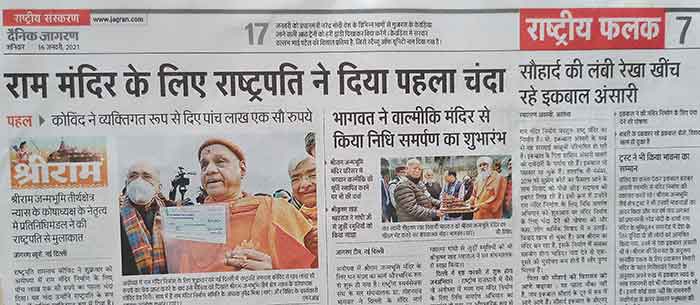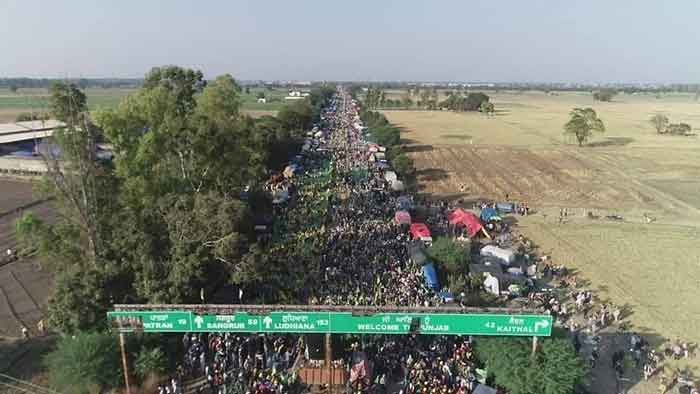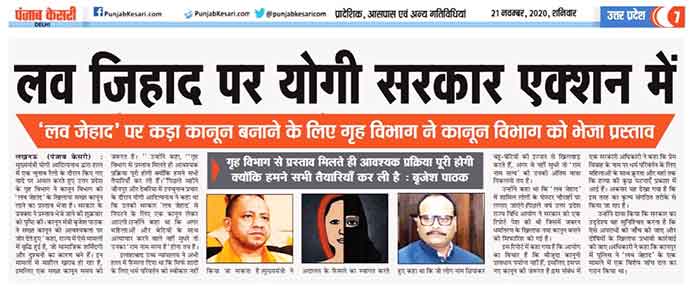
Last week the media – particularly Hindi newspapers – prominently covered the news of the construction work of the Ram Temple in Ayodhya. At times it appeared that the Ram Temple issue for media was a much bigger issue than the sufferings of people reeling under the corona pandemic.
The fact that the media is celebrating the beginning of the temple construction work and calling it a “manifestation” of “Hindu pride” amid growing pandemic has raised many eyebrows. Till Sunday morning the figure at the country-level shows that as many as 1,385,494 people have been tested positive with 32,096 deaths.
While India becomes the third-worst hit countries by Covid-19 followed by the USA and Brazil, Prime Minister Narendra Modi is planning to visit Ayodhya to perform a “groundbreaking ceremony” on August 5.
Hindi daily Jansatta (New Delhi, July 23, p. 3) carries a story, carrying Shri Ram Janmabhoomi Teertha Kshetra trust member Swami Govind Devgiri’s statement: “Prime Minister has consented to visit Ayodhya for performing bhoomipujan on August 5. He would stay in Ayodhya for half an hour”.
Dismissing the criticism of the opposition leaders regarding the timing of the event, Swami Devgiri says that the Ram temple construction is a “very important moment” because we have waited for five centuries to witness it.
If Modi as Prime Minister goes to Ayodhya and performs the pooja, will it not go against the spirit of secularism enshrined in the Indian Constitution? Media does not consider such a question important and worth discussing.
Several political scientists have argued that Indian secularism does not ask the State to become “hostile” to religion. Rather, it calls for an equal respect to all religion (sarva dharm sambhav). Indian secularism is equally unambiguous in prohibiting the State from getting associated with any particular religion.
The proposed performance of the groundbreaking ceremony at Ayodhya by the Prime Minister Modi would lend further weight to the growing perception that the nature of the Indian State is increasingly becoming religious and majoritarian. The media coverage about the temple construction and the proposed visit of the prime minister has not touched upon these issues.
In the early 1950s a similar situation also arose before the first Prime Minister Jawaharlal Nehru. He, however, believed that public officials should avoid associating with a particular faith publically. Nehru strongly believed that having an equal respect for all faiths is quite different from promoting or associating with one religion.
In 1951 when Somnath Temple was restored, Nehru advised President Rajendra Prasad not to participate in the temple function. Prasad, however, did not accept Nehru’s advice and went ahead with his plan.
Historians say that Somnath temple was raided by Mahmud of Ghazni in the eleventh century and its restoration was seen by the Hindu right as a revival of the so-called “Hindu glory”. Unfortunately, Hindi dailies largely ignored these political and historical aspects.
For example, Hindi daily Haribhoomi (New Delhi, July 23, p. 1) publishes a giant picture of the proposed Ram Temple. The image, printed on the front-page, resembles the one circulated by the Hindutva organisations during the temple mobilisation. The daily carries bold headlines that proudly claims that “the breadth of Ram Temple would be enlarged by twenty mitres and over fifty-thousand devotees can sit in one of the two pavilions”.
Giving information about the temple construction in minute detail, Haribhoomi writes that the original design of the Ram Temple, made in 1985-86, is undergoing some changes. These include increasing its breadth. Moreover, the temple would be a three-storied structure with each floor sitting on 106 pillars. The structure’s height, width, and breadth would be 161 fit, 235 fit, and 360 fit, respectively.
The reporting of Haribhoomi does not raise any questions about the timing. Nor does it raise finger at why such a big priority is given to the temple issue. The media seems to stoop further low when it calls the construction work as “normal” and a question of “faith”.
Is the construction of the temple such a normal event? Would the media have responded in the same manner if a grand mosque, not the temple, was to be constructed amid corona pandemic? The media should answer these questions.
Among the Hindi dailies, Dainik Jagran seems to be playing a leading role in popularising and publicizing the Ram temple construction. It has carried stories after stories over several days, praising the construction work. In a front-page story on Sunday (July 26), the daily calls the construction as “realisation of a dream”. The story claims that well-known architecture and consultant companies have been employed in this work.
In another front-page story (July 24), Dainik Jagran tries to “appropriate” the name of Buddha. Its heading reads that “Vinay from Buddhist land will perform bhoomipujan” (Buddh ki dhara ke Vinay karenge Shriram mandir ka bhoomipujan). Having read the story, it was learnt that one Vinay Pandey from Kushinagar district in Uttar Pradesh is going to conduct bhoomipujan to be attended by Prime Minister Modi.
Kushinagar is a well-known Buddhist pilgrimage site where Lord Buddha, as the Buddhists believe, attained parinirvana after his death. Just because the officiating priest Pandey belongs to Kushinagar, the daily draws the wild conclusion that the Buddhist stream is going to flow to ‘Hindutva ocean’ in Ayodhya!
Writing an editorial, Hindi daily Pioneer (23 July) calls the Ram temple construction as the “manifestation” (prakatikaran) of “Hindu pride” (Hindu gaurav). The daily appears to be upholding superstitious belief that the rituals to be performed in Ayodhya may help fight the coronavirus!

While the media is going gaga over the beginning of Ram temple construction, former BJP presidents L.K. Advani and Murli Manohar Joshi, accused in the Babri Masjid demolition case, have appeared before the special CBI court and recorded their statements. But the media does not find time to write stories about the fact that if Advani and Joshi have not conspired to bring the mosque down, who has really done it? Can it be denied that the mosque did not fall but it was made to fall?
Remember that the demolition of the sixteenth-century Babri Masjid took place on December 6, 1992. The mosque was reduced to debris by Hindutva forces in broad daylight in the presence of the national and international media.
Was the demolition merely an accident? No, there is a strong evidence to suggest that the demolition of the mosque was a planned act. The plan was made to polarise the voters along the religious lines. At a time when the anti-caste Mandal agitation was shaking up the roots of the Brahminical society, the demolition was carried out as a counter-revolutionary act.
During the Ram Temple mobilisation, the hatred against the Muslims was deliberately spread and an image of the “enemy” — outside the Hindu society — was systematically constructed to consolidate the illusory Hindu unity. The demolition was also thought as a necessary step to divert the attention of the public from massive privatisation and liberalisation. Above all, the agenda was to bring the far-right political parties, led by the BJP, to the centre of power. These real facts are conveniently forgotten by the media.
On November 9 last year, the Supreme Court — giving a long-awaited verdict on the Babri Masjid-Ram temple dispute case — awarded the disputed site to Hindus. The disputed site is the exact place where the mosque stood for centuries and it was demolished on December 6. The Supreme Court verdict on Ayodhya — while disappointing a large number of secular people, facilitated the construction of the Ram temple.
(Abhay Kumar is a Ph.D. from JNU. He is broadly interested in Minority and Social Justice. Earlier, he held a Post-Graduate Diploma in English Journalism from Indian Institute of Mass Communication, New Delhi and worked as a Delhi-based reporter with The Indian Express. You may write to him at [email protected])
SIGN UP FOR COUNTERCURRENTS DAILY NEWSLETTER

















































